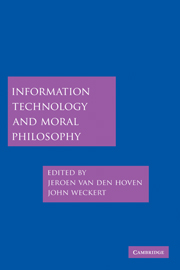Book contents
- Frontmatter
- Contents
- List of Contributors
- Introduction
- 1 Norbert Wiener and the Rise of Information Ethics
- 2 Why We Need Better Ethics for Emerging Technologies
- 3 Information Ethics: Its Nature and Scope
- 4 The Transformation of the Public Sphere: Political Authority, Communicative Freedom, and Internet Publics
- 5 Democracy and the Internet
- 6 The Social Epistemology of Blogging
- 7 Plural Selves and Relational Identity: Intimacy and Privacy Online
- 8 Identity and Information Technology
- 9 Trust, Reliance, and the Internet
- 10 Esteem, Identifiability, and the Internet
- 11 Culture and Global Networks: Hope for a Global Ethics?
- 12 Collective Responsibility and Information and Communication Technology
- 13 Computers as Surrogate Agents
- 14 Moral Philosophy, Information Technology, and Copyright: The Grokster Case
- 15 Information Technology, Privacy, and the Protection of Personal Data
- 16 Embodying Values in Technology: Theory and Practice
- 17 Information Technology Research Ethics
- 18 Distributive Justice and the Value of Information: A (Broadly) Rawlsian Approach
- Select Bibliography
- Index
- References
11 - Culture and Global Networks: Hope for a Global Ethics?
Published online by Cambridge University Press: 21 July 2009
- Frontmatter
- Contents
- List of Contributors
- Introduction
- 1 Norbert Wiener and the Rise of Information Ethics
- 2 Why We Need Better Ethics for Emerging Technologies
- 3 Information Ethics: Its Nature and Scope
- 4 The Transformation of the Public Sphere: Political Authority, Communicative Freedom, and Internet Publics
- 5 Democracy and the Internet
- 6 The Social Epistemology of Blogging
- 7 Plural Selves and Relational Identity: Intimacy and Privacy Online
- 8 Identity and Information Technology
- 9 Trust, Reliance, and the Internet
- 10 Esteem, Identifiability, and the Internet
- 11 Culture and Global Networks: Hope for a Global Ethics?
- 12 Collective Responsibility and Information and Communication Technology
- 13 Computers as Surrogate Agents
- 14 Moral Philosophy, Information Technology, and Copyright: The Grokster Case
- 15 Information Technology, Privacy, and the Protection of Personal Data
- 16 Embodying Values in Technology: Theory and Practice
- 17 Information Technology Research Ethics
- 18 Distributive Justice and the Value of Information: A (Broadly) Rawlsian Approach
- Select Bibliography
- Index
- References
Summary
INTRODUCTION
From Global Village to Electronic Metropolis
At the height of 1990s, optimism regarding the rapidly expanding Internet and World Wide Web, Marshall McLuhan's vision of a global village seemed within more or less easy reach. By wiring the world, it was argued in many ways, we would enter into the ‘secondary orality of electronic culture’ (Ong 1988) and thereby open up an electronic information superhighway that would realize a genuinely global village – one whose citizens would enjoy the best possibilities of democratic politics, social and ethical equality, freedom of expression, and economic development.
This optimism, however, was countered by increasing tensions in the economic, political and social arenas between two contrasting developments. On the one hand, the phenomena of globalization – including, for example, growing internationalization and interdependencies of markets – appear to lead to increasing cultural homogenization. As terms for this homogenization such as ‘McWorld’ (Barber 1995) or ‘Disneyfication’ (Hamelink 2000) suggest, it is strongly shaped by the consumer and entertainment cultures of Western nations. On the other hand, and at least in part in reaction against real and perceived threats to given cultural traditions and identities, new (or renewed) efforts to defend and sustain these identities and traditions were seen by some to lead to fragmentation and indeed violence – most famously and disastrously, of course, in the attacks of September 11, 2001 against the World Trade Towers and the Pentagon.
- Type
- Chapter
- Information
- Information Technology and Moral Philosophy , pp. 195 - 225Publisher: Cambridge University PressPrint publication year: 2008
References
- 19
- Cited by

